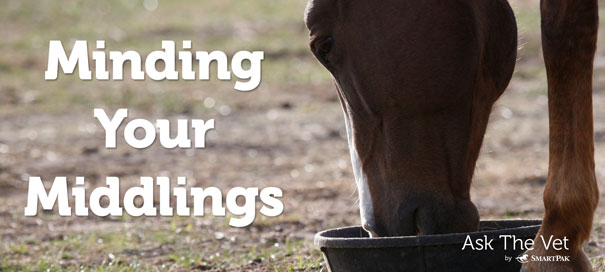Wheat Middlings for Horses - Feeding Tips for Nutrition

I have three quarter horses and a TN walker. Their diet is high quality forage (hay and pasture) with a mix of pelleted feed (low carb/no corn) and timothy pellets, supplemented with Gro strong vitamin and minerals, freshly ground flax seed, and biotin. They look great with a body condition score of 5 to 6. I have searched for a grass hay based feed that does not contain wheat middlings or beet pulp. The commercial feed manufacturers do not consider wheat middlings grain because they sell ‘grain free’ feeds with wheat middlings as the primary ingredient. What is the nutritional benefit of the wheat middlings to the horse, or is a cheap filler? – Jonica L. via AAEP Ask the Vet
Sounds like you’re doing a great job feeding your horses! To answer your wheat middlings question, I turned to AAFCO (Association of Animal Feed Control Officials), who defines it as a grain by-product that “consists of fine particles of wheat bran, wheat shorts, wheat germ, wheat flour, and some of the offal from the ‘tail of the mill.’ This product must be obtained in the usual process of commercial milling and must contain not more than 9.5% crude fiber.”
My other go-to source for equine nutrition, The Sixth Edition of Nutrient Requirements of Horses, says the inclusion of wheat GRAIN in horses diets is somewhat uncommon. However, wheat by-product feeds are often used in horse feeds, wheat middlings (midds) being one of the most common. Because most of the flour has been removed, wheat midds are higher in fiber and protein, but lower in energy than wheat grain. Wheat midds may contain more than 1 percent phosphorous so calcium supplementation is usually necessary when wheat midds constitute a significant portion of the diet. Due to their fine texture, wheat midds are not easily fed alone; however, they are commonly used in pelleted feeds.
Let me see if I can translate some of this nutrient-speak. First of all, don’t be alarmed by the use of the word “by-product.” I know the term scares some people off, but it doesn’t necessarily mean an ingredient is bad, all it means is that some ingredients, such as wheat midds, are not the main reason for processing wheat, which is primarily used to make flour for people. Because wheat midds are a by-product their quality and nutrient composition can vary, but in general this ingredient is high in protein, energy, starch, phosphorous, and potassium, with some trace minerals and vitamins to boot. So it does have nutritional value to the horse and for this reason as well as the fact that its fine texture helps bind pellets, you’ll see it in many commercial horse feeds.